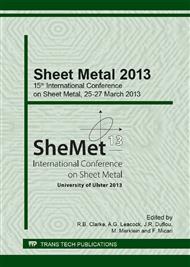p.61
p.68
p.76
p.84
p.92
p.100
p.108
p.117
p.125
Effects of Draw-Bending Characteristics on Concave Wall Feature in Rectangular Deep-Drawn Parts
Abstract:
In recent years, the requirements on the complicated deep-drawn parts with the high dimension precision are increasingly. As the major defect, the concave wall feature which commonly encounter in the complicated deep-drawn parts of the difficult-to-deep draw material is focused. In this research, the effects of draw-bending characteristics on concave wall feature during deep-drawing process are clearly identified. The mechanism of concave wall feature related to the draw-bending characteristic was investigated and clearly identified by using the finite element method (FEM) and the experiments were also performed to validate the FEM-simulation results. On the basis of stress distribution, the effects of draw-bending characteristics on the concave wall feature could be clearly identified via the changes of stress distributions on the wall, convex feature and spring-go feature on the bottom surface, and spring-back feature on the top surface. However, comparing with U-draw bending model, the effects of draw-bending characteristics was decreased and the concave wall feature in the case of deep-drawing model was smaller than that in the case of U-draw bending model. The experiments were carried out in both cases of the deep-drawing and U-draw bending models to validate the FEM-simulation results. The FEM-simulation results showed a good agreement with the experimental results with reference to the distribution of material thickness.
Info:
Periodical:
Pages:
92-99
Citation:
Online since:
April 2013
Authors:
Keywords:
Price:
Сopyright:
© 2013 Trans Tech Publications Ltd. All Rights Reserved
Share:
Citation:


